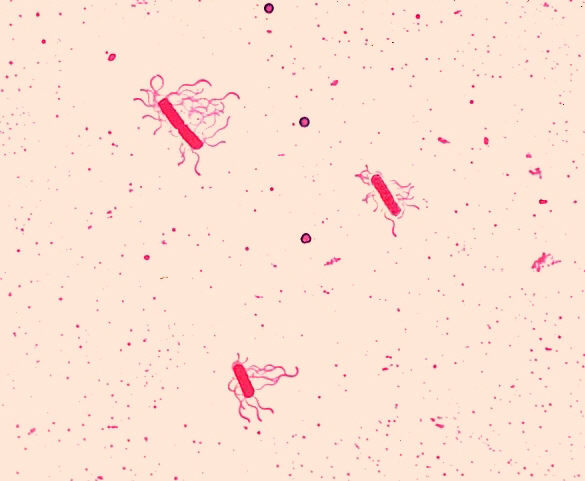Playlist
Show Playlist
Hide Playlist
Bacillus
00:01 Bacillus, a bacteria. Bacillus are gram-positive rods that are aerobic and are spore-forming. 00:08 Now, this is important because as we'll see, most of the pathogenesis from the Bacillus species comes from those spores and they get everywhere. 00:18 Importantly, Bacillus is one of the bacterium, in fact, the only one with a completely polypeptide capsule. 00:26 This is important in protecting it from the attack of the human immune system. 00:30 Now, we talk about or recognize two medically important Bacillus species. 00:35 The first is Bacillus anthracis, the cause of anthrax. Most cases of anthrax are cutaneous, skin-associated, and they're inoculated by a vector, a fly. 00:47 However, Bacillus anthracis is one of the few organisms that unfortunately, has been weaponized as a cause of bioterrorism and we'll talk briefly about that as well. Bacillus cereus is the other important species. 01:01 It is commonly referred to as B cereus as it is a cause of very significant emesis, vomiting disease related to spores created in rice. 01:13 When anybody has had that particular infection, it is no laughing matter, hence, B cereus is a common microbiology joke. 01:21 Let's talk first about pathogenesis and we'll focus on Bacillus anthracis. 01:26 Bacillus anthracis contains two toxins important for its pathogenesis and they're introduced by a third factor which allows the toxins to be introduced. 01:37 The first toxin is edema factor and this is important for modifying AMP within the target cell, creating it into a cyclical form. 01:48 The presence of cyclic AMP increases the presenting factor of edema or fluid leaking from the cell due to protein synthesis inhibition. 02:00 The second factor, the lethal factor, cleaves phosphokinase which also is important in cellular machinery and protein synthesis. 02:09 The combination of these two lethal and edema factors is very important in killing the target cell. 02:16 However, they require the presence of the third toxin or the protective protein which creates a cluster of seven different protein factors at the cell's surface, in an effect, creating a porin or a channel through which the edema and the lethal factor introduce. 02:35 Again, as noted, the capsule of Bacillus anthracis is antiphagocytic, so, the combination of all these together leads to the diseases caused by Bacillus anthracis. 02:46 What happens with the spores? How does one get infected with Bacillus anthracis? As you see at the top of the slide, there is a biting fly which seems to be central to cases of anthrax and in most parts of the world, this is true. 03:01 The fly infects itself with spores coming from decompensated waste or stool from bovine sources, other infected animals, and then, can bite and introduce anthracis spores into anybody including the human being. 03:18 However, the spores exist in vegetable material and decomposition all over the world, typically, sporulating in the presence of heat or humidity and then, they can be ingested or inhaled, or even stepped upon and ejected that way. 03:38 A very famous source of anthrax came from a person living in New York City who purchased tribal drums from Africa. 03:46 Unfortunately, there were spores present in the hide which had been used as the drum head and as soon as this person in New York started beating the head of that drum, he inhaled anthrax spores and acquired inhalational anthrax. 04:00 Note to self, don't buy drums from tribal Africa. 04:04 Now, let's talk about pathogenesis of Bacillus cereus or B cereus. 04:09 In this case, the cyclic AMP is increased within enterocytes, the small cells lining the gut. 04:16 In addition to causing edema via that factor, they are a heat-stable enterotoxin which is associated with rapid onset of vomiting and a heat-labile enterotoxin which when present, is associated with onset of non-bloody diarrhea and abdominal cramps. 04:35 Of the three, the cyclic AMP is present almost all cases and the heat stable enterotoxin is present almost all the cases as well. 04:44 B cereus is primarily a very unpleasant hyperemesis disease. 04:50 Now, let's compare the two organisms and their diseases side to side. 04:55 Here, if you look at the habitat for Bacillus anthracis and Bacillus cereus, we see that the spores are ubiquitous almost anywhere. 05:04 For Bacillus anthracis as noted before, the spores exist in the soil but also, in animal sources and those horrible drum heads in tribal drums. 05:14 Bacillus cereus is found also in the soil but also, it can be transmitted into food sources. 05:19 The frequent exposure in this case is undercooked rice, especially with Asian themed dishes and in cases where the rice has been left to stew for a while. 05:31 Transmission, Bacillus anthracis, it's typically occupational whether it's inhalation of the spores as we noted or ingesting of the spores themselves. 05:42 Occasionally, the spores are introduced through the bite of a biting fly. 05:46 For Bacillus cereus as noted, the reheated rice syndrome is important and it is a frequent contamination of reheated foods. How to identify the organisms? Again, Bacillus are gram-positive rods and they're spore-forming but in Bacillus anthracis under the microscope, the spores and the organisms are non-motile, they don't move. However, Bacillus cereus are motile. 06:12 You can see them wiggle under the microscope. 06:14 Both organisms are aerobic, requiring oxygen. 06:17 Further, for Bacillus anthracis, when looking at it in culture growth on blood agar, it appears to grow in medusa-head colonies, little snakelike forms of the organisms clustered together. 06:30 With Bacillus anthracis, the toxins are the exotoxin present in that capsule which inhibits phagocytosis. 06:38 The protective factor which again clusters at the cell's surface to allow injection or introduction through a porin of the edema factor and the lethal factor. 06:48 Those last two factors together have to do with inhibiting cell function, protein synthesis, and creating edema and death of the cell. 06:58 For Bacillus cereus, there are two toxins, the heat stable exotoxin which creates vomiting and the heat-labile exotoxin which creates that secretory diarrhea. 07:09 Both toxins may be present, although most commonly, it is the heat-stable exotoxin with the vomiting. 07:16 How does one typically develop disease with these two? Bacillus anthracis, the most common form of disease is cutaneous anthrax as mentioned before. 07:27 This could be inoculated through the bite of the fly or through some other pointed object. 07:32 Typically, patients with anthrax will develop a small papule which may be somewhat pruritic but it rapidly develops over several days into a deep ulcer which has vesicles, lots of edema or swelling, and then, secondary necrosis, septicemia, and frequently death. 07:52 The necrotic ulcer that develops in cutaneous anthrax presents characteristically with a painless black center known as eschar. 08:00 The ulcer heals within 3-4 weeks and leaves hyperpigmentation or scarring. 08:05 Pulmonary anthrax is due to inhalation of the spores and it starts as a viral-like illness progressing rapidly to respiratory failure and there's a high mortality. 08:17 If you recall from the short days of anthrax as a bioterrorism agent, patients were inhaling the spores delivered through the mail system and they were developing rapid onset of respiratory failure and some deaths. 08:34 Bacillus cereus is notable for as a source of food poisoning, very unpleasant food poisoning. 08:41 Rapid onset within 1-5 hours of ingestion so the patients frequently know exactly where they got the food poisoning from, and the restaurant and the dish. 08:52 Patients such as those will have initial onset of nausea, followed by hyperemesis, the vomiting, and then severe abdominal cramps. 09:02 Some of those patients may go on to develop a watery or a non-bloody diarrhea and again, the cramps are present. 09:09 Because that is a heat stable toxin, it takes 10-15 hours of ingestion-developed disease. 09:16 What do we do? How to prevent either organism from causing disease? In the case of Bacillus anthracis, we can vaccinate animals. 09:25 We certainly can create proper disposal of infected animals and there is a vaccine for patients who are at risks. 09:33 You see them listed on this slide: fur and wool handlers, the military, physicians or healthcare providers responding to areas which may be endemic for anthrax. 09:44 Treatment of anthracis is amoxicillin or penicillin if the organism is sensitive. 09:51 However, we frequently don't have time to realize or discover the susceptibility pattern so most often, patients will start with ciprofloxacin or secondarily, a tetracycline such as doxycycline. 10:04 Again, you may recall during the anthrax scares in the States, there was a run on the drug ciprofloxacin and people were going across the border to Mexico to pick up stores of the antibiotic without a prescription. 10:18 Bacillus cereus, prevention is typically through refrigerating the foods after cooking or avoiding re-cooked rice if at all possible. 10:27 Also, if your friends tell you they acquired really bad vomiting from a certain restaurant, you may wish to go some place else. 10:34 If, however, one fails to heed that excellent advice and develops hyperemesis vomiting disease, then supportive therapy is your friend. 10:43 Replenishing the fluids, replenishing the electrolytes. 10:46 So, that wraps up what we know about Bacillus. 10:48 Again, two major forms: anthracis and cereus. 10:52 One, very serious, but not the cereus one. 10:55 The other is serious but not all that bad if you can support yourself.
About the Lecture
The lecture Bacillus by Sean Elliott, MD is from the course Bacteria.
Included Quiz Questions
Which of the following species belonging to the Bacillus genus is most likely to be implicated if a patient presents with "reheated rice syndrome"?
- Bacillus cereus
- Bacillus thuringiensis
- Bacillus anthracis
- Bacillus subtilis
- Bacillus mycoides
Which of the following refers to the pathogenic mechanism of action of the edema factor produced by Bacillus anthracis?
- Increase in cyclic AMP
- Decrease in cyclic AMP
- Cleavage of phosphokinase
- Increase in cyclic GMP
- Decrease in cyclic GMP
Which of the following is responsible for the manifestation of rapid-onset, excessive vomiting in patients infected with Bacillus cereus?
- Heat-stable enterotoxin
- Heat-labile enterotoxin
- Lethal factor
- Edema factor
- Protective factor
Which of the following characteristic findings is observed on blood agar when growing a specimen obtained from an individual infected with Bacillus anthracis?
- Medusa-head colonies
- Alpha-hemolysis
- Beta-hemolysis
- Double-zone hemolysis
- Pinpoint colonies
Which of the following brings about the cleavage of phosphokinase in the cells of a patient who has cutaneous anthrax?
- Lethal factor
- Edema factor
- Heat-labile exotoxin
- Heat-stable exotoxin
- Protective factor
Food poisoning manifesting as nausea, abdominal cramps, and excessive vomiting due to infection with Bacillus cereus usually develops within how many hours after ingestion of the contaminated food?
- Within 5 hours
- Within 8 hours
- Within 12 hours
- Within 18 hours
- Within 24 hours
Customer reviews
5,0 of 5 stars
| 5 Stars |
|
1 |
| 4 Stars |
|
0 |
| 3 Stars |
|
0 |
| 2 Stars |
|
0 |
| 1 Star |
|
0 |
Really liking the microbio bacteria videos. Feel like the presentation of the info is well done and really easy to grasp in such a short amount of time.




